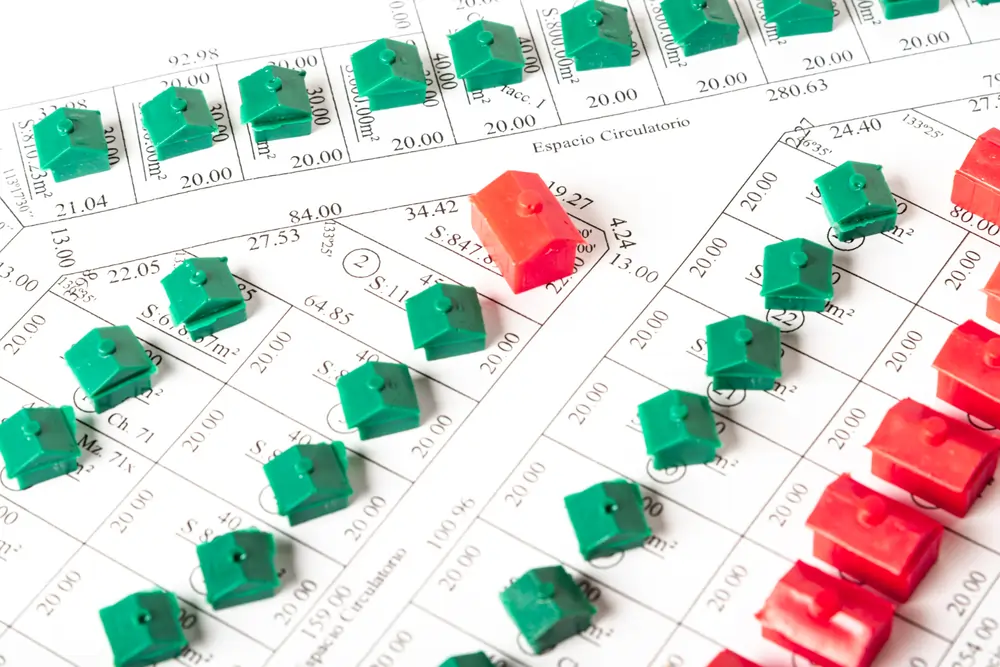In today’s fast-paced real estate market, finding the right property at the right price can feel like searching for a needle in a haystack. But what if there was a tool that could make this process easier, faster, and more accurate? Enter the property value map – a game-changing resource that’s revolutionizing how we evaluate real estate in 2024.
Whether you’re a first-time homebuyer, seasoned investor, or curious homeowner, understanding how to use a property value map can give you a significant edge in the market. But with so many options available, where do you start? And how can you be sure you’re interpreting the data correctly?
In this comprehensive guide, we’ll walk you through everything you need to know about property value maps – from what they are and how to read them, to the benefits they offer and the potential pitfalls to avoid. By the end, you’ll be equipped with the knowledge to make smarter, more informed real estate decisions. So, are you ready to unlock the power of property value maps? Let’s dive in!
Property Value Map
When it comes to buying or selling property, having an accurate understanding of real estate prices is crucial! One of the best tools to help you visualize property values in specific areas is a property value map. These maps provide a clear breakdown of real estate trends across neighborhoods, giving you the data you need to make informed decisions—whether you’re investing in your first home or your tenth.
Did you know that according to recent reports, property value maps have helped investors increase their ROI by up to 20% by identifying upcoming market trends early? These maps are becoming an indispensable tool for both buyers and sellers, especially as property values fluctuate in 2024. Let’s dive into how to leverage them to your advantage!
What is a Property Value Map?
 Ever wondered how much your land is worth? A Property Value Map is a super handy tool for that! It shows land value and property boundaries in your county. Using GIS technology, these maps improve the work of an appraiser by making it more interactive. You can even view a free online plat map to get property lines!
Ever wondered how much your land is worth? A Property Value Map is a super handy tool for that! It shows land value and property boundaries in your county. Using GIS technology, these maps improve the work of an appraiser by making it more interactive. You can even view a free online plat map to get property lines!
This tool is a game-changer for real estate professionals, helping them assess the potential of a parcel of land and enhance its productivity. From Henderson County to Wayne County, these maps provide relevant property data and parcel information nationwide. Whether you’re a landowner or in the mortgage industry, these maps assist in spatial analysis and market exploration.
Imagine having expert-level property information at your fingertips, visually presented with mapping software. It’s not just for the pros; even if you own a small acre of farm land, these maps can help you understand every aspect of your property. Counties like Benton, Carroll, Chester, Decatur, Gibson, Hardin, Madison, McNairy, Perry, and more can all benefit.
A property value map, also known as a home price map or real estate value map, is a visual representation of property prices in a specific area. These maps use color-coding and other visual cues to show the relative values of properties across neighborhoods, cities, or even entire regions.
Definition and Basic Features
At its core, a property value map is a real estate data visualization tool that aggregates and displays property values geographically. These maps typically use a color gradient to represent different price ranges, with warmer colors (like red or orange) often indicating higher values and cooler colors (like blue or green) representing lower values.
Data Aggregation
Property value maps draw data from various sources to provide a comprehensive view of the market. These sources typically include:
- Tax records
- Recent sales data
- Current listings
- Historical price trends
By combining these data points, property value maps offer a more accurate and up-to-date picture of the market than any single source could provide alone.
Importance for Market Assessment
In today’s dynamic real estate landscape, relying on outdated methods of market assessment can lead to costly mistakes. Property value maps have become an essential tool for accurate market analysis because they:
- Provide a bird’s-eye view of an area’s property values
- Allow for quick comparisons between neighborhoods
- Highlight trends and patterns that might not be obvious from raw data
Common Platforms
Several online platforms offer property value maps, including:
- Zillow property value map
- Trulia home price map
- Redfin real estate value map
Each of these tools has its unique features and data sources, which we’ll explore in more detail later in this article.
How to Read and Interpret a Property Value Map
 Hey there! If you’re diving into the world of property values, an interactive map is your best friend. You can view free online plat map and get a great presentation of plat map and land details. Whether you’re in Benton County, Carroll County, Chester County, or any of the other counties like Decatur County, Gibson County, Hardin County, Madison County, McNairy County, or Perry County, these tools can help you identify potential properties to invest in.
Hey there! If you’re diving into the world of property values, an interactive map is your best friend. You can view free online plat map and get a great presentation of plat map and land details. Whether you’re in Benton County, Carroll County, Chester County, or any of the other counties like Decatur County, Gibson County, Hardin County, Madison County, McNairy County, or Perry County, these tools can help you identify potential properties to invest in.
Real estate pros use these interactive maps to communicate property values, integrate statistics, and customize their searches. It’s all about efficiency! With a market explorer tool, you can tailor your search to find properties with the right infrastructure and total acres. And guess what? This can save you tons of time and help you succeed in your investments.
These maps are not just for experts; even if you’re new, you can use them to advance your knowledge and efficiently explore the potential of property. They offer an in-depth look at the economic development of areas, helping you make informed decisions. Plus, with over 1.5 million properties listed, you’re bound to find something that fits your needs.
Now that we understand what property value maps are, let’s dive into how to use them effectively. Reading a property value map correctly can mean the difference between spotting a hidden gem and overpaying for a property. So, what should you look for?
Key Indicators
When examining a property value map, pay attention to:
- Price ranges: Most maps use color coding to represent different price brackets.
- Color codes: Generally, warmer colors indicate higher values, while cooler colors represent lower values.
- Trends: Look for patterns or clusters of similar colors to identify high-value or low-value areas.
Identifying Value Zones
To spot high-value and low-value zones:
- Look for clusters of similarly colored properties
- Pay attention to sudden changes in color, which might indicate boundaries between different value zones
- Consider the surrounding areas and amenities that might influence property values
Avoiding Misinterpretations
While property value maps are powerful tools, they’re not infallible. Common misinterpretations include:
- Assuming all properties in a color zone are of equal value
- Ignoring recent market changes that might not be reflected in the map
- Overlooking individual property characteristics that can affect value
To avoid these pitfalls, always use property value maps as a starting point for further research, not as the final word on a property’s worth.
Practical Example
Let’s say you’re looking at a property value map of a suburban area. You notice a neighborhood with mostly blue-colored properties (lower values) surrounding a small cluster of orange properties (higher values). This could indicate an up-and-coming pocket within a more affordable area – potentially a great investment opportunity.
But before jumping to conclusions, you’d want to investigate further. What’s causing the value difference? Is it newer construction? Better amenities? Understanding these factors is crucial for making informed decisions.
Benefits of Using a Property Value Map for Home Buyers
 Hey there! If you’re house hunting, a property value map is your new best friend. This tool for real estate professionals brings some serious expertise to the table, helping you pinpoint the right address without the hassle. It’s super intuitive and can even aid in the appraisal process, making sure you get bang for your buck. Plus, it can save time and make you feel like a real estate brand pro!
Hey there! If you’re house hunting, a property value map is your new best friend. This tool for real estate professionals brings some serious expertise to the table, helping you pinpoint the right address without the hassle. It’s super intuitive and can even aid in the appraisal process, making sure you get bang for your buck. Plus, it can save time and make you feel like a real estate brand pro!
For home buyers, property value maps can be a game-changer. They offer several key advantages that can help you make smarter purchasing decisions:
Transparency in Real Estate Prices
Property value maps provide an unprecedented level of transparency in the real estate market. By visualizing price data across entire neighborhoods or cities, they allow buyers to:
- Quickly gauge the general price range in their desired area
- Spot potential bargains or overpriced listings
- Understand how location affects property values within a specific region
Comparing Neighborhood Values
One of the most powerful features of property value maps is their ability to facilitate easy comparisons between different neighborhoods. This can help buyers:
- Identify areas that offer the best value for their budget
- Discover up-and-coming neighborhoods they might have overlooked
- Make more informed decisions about where to focus their search
Identifying Growth Areas
For savvy buyers looking to maximize their investment, property value maps can be invaluable in spotting areas with potential for appreciation. By analyzing trends over time, you can:
- Identify neighborhoods where values are steadily increasing
- Spot areas where new developments or improvements might drive up future values
- Make more informed long-term investment decisions
Real-Life Success Stories
Consider the case of Sarah, a first-time homebuyer in Austin, Texas. Using a property value map, she noticed a small pocket of lower-priced homes in an otherwise expensive neighborhood. Upon investigation, she discovered these homes were part of an older development that was due for renovation. By purchasing one of these homes, Sarah was able to buy into a desirable area at a fraction of the typical cost, and her property value increased significantly over the next few years as the renovation plans were implemented.
How Investors Can Use Property Value Maps to Maximize ROI
 For real estate investors, property value maps are not just useful – they’re essential. Here’s how savvy investors are using these tools to maximize their returns:
For real estate investors, property value maps are not just useful – they’re essential. Here’s how savvy investors are using these tools to maximize their returns:
Spotting Undervalued Properties
Property value maps excel at highlighting potential “diamonds in the rough.” Investors can:
- Identify properties priced below the neighborhood average
- Spot areas where property values don’t match the quality of amenities or location
- Find properties with high potential for value-add improvements
Tracking Market Trends
By comparing property value maps over time, investors can:
- Identify emerging “hot spots” before prices skyrocket
- Spot neighborhoods that are declining in value and might offer renovation opportunities
- Understand broader market trends to inform their investment strategy
Comprehensive Market Analysis
While property value maps are powerful on their own, combining them with other tools can provide even deeper insights. Investors often use them alongside:
- Demographic data: To understand population trends and potential rental demand
- Zoning maps: To identify areas with potential for development or rezoning
- Economic indicators: To gauge the overall health of a local real estate market
Case Studies
Take the example of Mark, a real estate investor in Chicago. Using property value maps, he noticed a sharp divide in prices between two adjacent neighborhoods. Further research revealed that one neighborhood was on the cusp of a major redevelopment project. By purchasing several properties in the lower-priced area just before the project was publicly announced, Mark was able to achieve a 40% return on investment within just two years.
Challenges and Limitations of Property Value Maps
While property value maps are incredibly useful, they’re not without their limitations. Understanding these challenges is crucial for using these tools effectively:
Data Accuracy and Delays
Property value maps are only as good as the data they’re based on. Some potential issues include:
- Outdated information, especially in fast-moving markets
- Inaccuracies in public records or listing data
- Delays in reflecting recent sales or market changes
Rapidly Changing Markets
In areas experiencing rapid growth or decline, property value maps may struggle to keep pace. Users should be aware that:
- Values in “hot” markets might be higher than reflected on the map
- Areas in decline might show artificially high values based on historical data
Overreliance Without Additional Research
Perhaps the biggest pitfall is relying too heavily on property value maps without conducting additional research. Remember:
- Maps don’t account for the condition of individual properties
- They can’t factor in intangible elements like neighborhood atmosphere or future development plans
- Local market knowledge is still crucial for making informed decisions
Top Property Value Map Tools in 2024
With the growing popularity of property value maps, several tools have emerged as leaders in the field. Here’s an overview of some of the best options available:
- Zillow’s Property Value Map
- Pros: Extensive database, user-friendly interface
- Cons: Can be less accurate in some rural areas
- Trulia’s Home Price Map
- Pros: Detailed neighborhood information, crime data overlay
- Cons: Updates can be slower than some competitors
- Redfin’s Real Estate Value Map
- Pros: Frequent updates, integration with listing data
- Cons: Limited coverage in some regions
- ATTOM Data Solutions
- Pros: Comprehensive data, suitable for professional investors
- Cons: Higher cost, steeper learning curve
When choosing between free and paid tools, consider your specific needs. While free tools like Zillow can be great for casual research, serious investors or professionals might benefit from the more detailed data and analysis tools offered by paid services.
Conclusion
Property value maps are an incredibly valuable tool for anyone involved in real estate. Whether you’re a home buyer, seller, or investor, understanding how to read and use these maps can give you an edge in a competitive market. They offer transparency, allow for easy comparisons, and help you spot trends before they become obvious to others. However, it’s essential to combine them with other research methods to ensure accuracy. Ready to dive deeper into real estate? Start using property value maps today, and watch your real estate knowledge grow!
Property value maps have revolutionized how we evaluate real estate in 2024. By providing a visual, easy-to-understand representation of property values across different areas, these tools empower buyers, sellers, and investors to make more informed decisions. However, it’s crucial to remember that they’re just one piece of the puzzle. For the best results, use property value maps in conjunction with other research methods and local market knowledge.
So, are you ready to start exploring the world of property value maps? With the insights you’ve gained from this guide, you’re well-equipped to navigate the real estate market with confidence. Happy house hunting!



